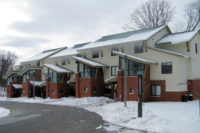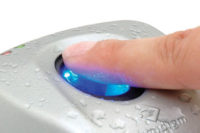
|
In an effort to state the state more than $13 million, the Michigan Department of Corrections has decided to eliminate the armed officers who protect the perimeter of 27 state prisons. The concern is that no one will be around to stop weapons, drugs, or other items from being thrown over the barbed wire fences to inmates. Instead, surveillance cameras around the perimeters will replace 120 patrol officers.
“We will have cameras watching those locations so that an officer sitting inside one of the prisons can see someone approach the fence and dispatch a vehicle with an armed officer,” says Russ Marian, a spokesperson for the Michigan Department of Corrections. “The cameras will provide an enhanced level of security. We can watch all parts of a perimeter fence at all times instead of having one officer circling around.”
While local residents living in neighborhoods that surround the prisons are concerned about their personal safety, the trend of using surveillance cameras as a replacement or backup for security personnel is one that is growing. As a matter of fact, IMS Research forecasts that the global network security camera market will exceed $4 billion in 2015. “Day/night surveillance cameras provide another tool in the arsenal of tools that security has for surveillance or early detection,” says Wayne A. Stotts, a project manager for nuclear facilities. He has deployed FLIR thermal cameras and low-light cameras in various nuclear facilities to detect perimeter intrusion around controlled areas. “When coupled with video analytics, these tools along with other tools installed give our security force the advantage they may need to detect and deter any intruders well in advance of a real threat” he says.
As the movement toward video cameras continues to evolve, so too does the technology. The emergence of high-definition video and improved megapixel resolution has companies moving away from analog systems. Additionally, video surveillance is now migrating towards computer networks, transmitting video by Internet Protocol (IP) or Power over Ethernet (PoE).
Cameras Take to the Streets
Law enforcement officials in Brockton, MA, view their security cameras as the backbone of their security force on the streets. The police department used federal money to purchase more than a dozen VB-C60 IP security PTZ (pan/tilt/zoom) cameras from Canon. The cameras are part of a public-safety surveillance system that was designed and installed by network integrator LCN. Developed during the past six years, the strategically located security cameras provide high-quality video, which Michele Thibeault, grant coordinator for the Brockton Police Department says is helping to make a difference in crime detection and prevention.
The cameras are positioned on intersections, streets, parking areas, and other places where illegal activity occurs. “Some of the cameras are visible to deter criminal activity while others are more hidden, but all can be manned 24 hours a day,” says Thibeault.
The camera’s panning range, its ability to capture clear images of moving objects, day/night capability and high-image resolution has made it easier for the Brockton Police Department to view crimes in progress and print quality video for courthouse evidence.
While crime statistics are not unavailable, Thibeault says that the cameras do act as another set of eyes and ears out on the streets. “People feel safer knowing the cameras are there and when criminals know they are being watched, the crime tends to move elsewhere,” she says.
As the security coordinator for the County of Maui, Dennis Schwind, executive assistant to the Managing Director for the County of Maui, knows a little something about crime. Schwind’s responsibilities include initiatives to provide protection to staff, residents, and visitors at all county facilities. In addition, he is responsible for maintaining a county-wide initiative that started after the terrorist attacks in 2001 to migrate towards a single system for all access control, biometric and surveillance systems. Maui County employees 2,500 people and has a population of 154,000 spread out over 2,400 square miles.
The county wanted to deploy day/night cameras to monitor county facilities — business offices, police stations, fire stations, water departments, golf courses, maintenance yards — after hours. “We have millions of dollars worth of vehicles parked outside, and in the past, we’ve had vehicles, tires and gasoline stolen,” says Schwind. In addition, after the tsunami of 2011, the mayor wanted to expand the surveillance system to the beaches and main highways to monitor these areas in case of an emergency.
Schwind and his team ultimately chose to deploy day/night camera from Tyco Security Products. This high-definition megapixel camera offers high-resolution capabilities and built-in facial detection capabilities, which Schwind plans to leverage in the future. The cameras enabled the county to reduce cable costs as these are PoE systems.
The cameras were placed outside municipal offices; police, fire and water department facilities; and municipal golf courses to monitor equipment during the night to prevent theft and vandalism. “We had one interesting incident happen before we installed our new day/night cameras,” explains Schwind. “Our maintenance people use a golf cart because the facility spans three separate buildings. One night, our old cameras picked up some headlights on a golf cart being stolen. Unfortunately, we couldn›t tell who was on the golf cart. But, I am confident that our new cameras could provide a clear image to help us identify a person in another situation like this. There is no sense having a camera if you can’t view the image and determine who is in the video.”
Going forward, Maui County is working with Security Resources, a security system integrator, to upgrade to high-definition megapixel cameras on a county-wide basis. Some have already been incorporated at the liquor department and the fire department’s headquarters in Kahului. “Overall, our goal is to continue to move forward with a single, standardized security system so we will have consistency in the types of security systems that we deploy and use on a daily basis,” says Schwind.
To Catch a Thief
From the beach to the mountains, crime knows no boundaries. And, there is no worse time to be the victim of a crime than when on vacation. Nick Franzosa, security director at Bear Creek Mountain Conference Center and Resort in Macungie, PA, is relying on surveillance cameras for guest safety.
Forty-two high-definition day/night cameras from Avigilon have been placed throughout the 330-acre resort to monitor the main hotel, parking lots, and even the mountains. “Not only do we want to use the cameras to track down someone who may steal a guest’s item, but we also use the cameras to protect the resort from fraudulent insurance claims,” says Franzosa.
Although the cameras are visible, Franzosa can’t know for sure if the systems are preventing crime, but he has used the cameras to catch his thief. “We had guests at the resort from Ocean City, MD, whose snowboard had been taken. Thanks to the closed circuit cameras at the ticket window, we were able to get a picture of the thief and match it to his scanned lift ticket for a name. We found the thief and the snowboard within 30 minutes.”
Franzosa can’t comment on the resort’s financial investment in the Avigilon cameras, but does believe that the investment in the system is well worth it. “Just having the cameras there to protect us from fraudulent claims is worth the money,” he says.
Day/night cameras allow another means for detection and surveillance in conditions or areas where low light cameras or vision cameras may not see the proposed threat,” says Stotts. “In the security world, having the means to detect any threat in time to respond is everything. You can’t put a price on that.”



